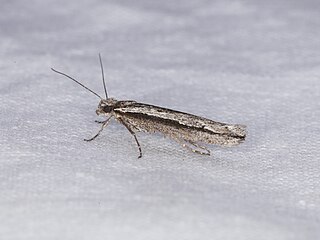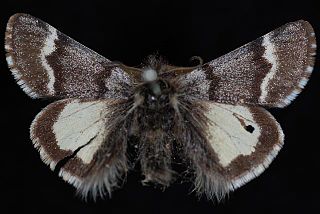
Ypsolophidae is a family of moths with some 160 species. They are included in the Plutellidae by many authors.

Chytolita is a monotypic litter moth genus of the family Erebidae erected by Augustus Radcliffe Grote in 1873. Its only species, Chytolita morbidalis, the morbid owlet moth or morbid owlet, was first described by Achille Guenée in 1854. It is found in large parts of North America, from coast to coast in the north and south to North Carolina, Texas and Florida in the west. The habitat consists of deciduous woods and edges.

Eumacaria is a monotypic moth genus in the family Geometridae described by Packard in 1873. Its only species, Eumacaria madopata, the brown-bordered geometer moth, was first described by Achille Guenée in 1857. It is found in North America, where it has been recorded from British Columbia, northern Washington, southern Saskatchewan, from Maine to Florida, South Dakota, North Dakota, Nebraska, Wyoming, Idaho, Colorado and New Mexico. The habitat consists of orchards and shrublands. The species is listed as threatened in Connecticut.

Apamea cinefacta is a moth of the family Noctuidae first described by Augustus Radcliffe Grote in 1881. It is found in western North America, including in Washington and Alberta.

Drasteria adumbrata, the shadowy arches, is a moth of the family Erebidae. The species was first described by Hans Hermann Behr in 1870. It is found from coast to coast in southern Canada, south in the west to California and Colorado, south in the east to New England and Michigan. Subspecies D. a. alleni is found from eastern Alberta to New York and Nova Scotia. Subspecies D. a. saxea occurs from southern British Columbia and south-west Alberta south to California and Colorado.

Pleromelloida conserta is a moth of the family Noctuidae first described by Augustus Radcliffe Grote in 1881. It is found in North America from British Columbia to California, east to Utah, north to Saskatchewan.
Ypsolopha dorsimaculella is a moth of the family Ypsolophidae first described by William D. Kearfott in 1907. It is found throughout North America. In Canada, it is known from British Columbia, Alberta and Saskatchewan. It is known from most of the continental United States. The habitat consists of mixed wood forests, riparian areas and possibly scrubland.
Ypsolopha dentiferella is a moth of the family Ypsolophidae first described by Lord Walsingham in 1881. It is found throughout North America. In Canada, it occurs in most provinces, being most frequently collected in British Columbia and Alberta. It has been found in a wide variety of habitats, including mixed wood forests, semi-arid scrubland, prairies and badlands.
Ypsolopha senex is a moth of the family Ypsolophidae first described by Lord Walsingham in 1889. It is found throughout North America. In Canada it occurs in most provinces, from British Columbia and Alberta to Manitoba. It is present in most of the continental United States. It is known from a wide variety of habitats, including riparian ecosystems, mixed wood forest and alpine tundra.

Ypsolopha canariella, the canary ypsolopha moth, is a moth of the family Ypsolophidae. The species was first described by Lord Walsingham in 1881. It is found throughout North America from sea level up to elevations of 1,830 meters. In Canada it occurs in most provinces, from British Columbia and Alberta to Ontario. It is present in most of the continental United States. It is known from a wide variety of habitats, including mixed wood forests, semi-arid scrubland, prairies and badlands.

Ypsolopha flavistrigella is a moth of the family Ypsolophidae first described by August Busck in 1906. It was known only from the southern part of the United States, but has also been recorded from Alberta, Canada.

Leucobrephos brephoides, the scarce infant moth, is a moth of the family Geometridae. The species was first described by Francis Walker in 1857. It is found in North America from Yukon to Labrador and south to New York and southern Alberta and British Columbia. The habitat consists of open mixed wood forests of the boreal and mountain region.

Ypsolopha is a genus of moths of the family Ypsolophidae. It is the type genus of the family and comprises over 120 described species.

Amblyptilia pica, the geranium plume moth, is a moth of the family Pterophoridae. The species was first described by Baron Walsingham in 1880. It is found in western North America from Alaska to California, inland to Alberta and Kansas. It is also found in the north-eastern United States and Ontario.
Lampronia aenescens is a moth of the family Prodoxidae first described by Walsingham in 1888. In North America it is found in Alberta and ranges west and south through southern British Columbia to northern California and Colorado.

Phaeoura quernaria, the oak beauty, is a moth of the family Geometridae. The species was first described by James Edward Smith in 1797. It is found in eastern North America, occurring as far west as east-central Alberta. The habitat consists of aspen-cherry shrubland.

Lycomorpha pholus, the black-and-yellow lichen moth, is a moth in the family Erebidae. It is found in North America from Nova Scotia to North Carolina, west to South Dakota and Texas. The habitat consists of short-grass prairie.
Anopina arizonana is a moth of the family Tortricidae first described by Lord Walsingham in 1884. It is found in North America from southern interior British Columbia and from Waterton Lakes, Alberta, south to Arizona.
Argyrotaenia occultana, the fall spruce needle moth, is a moth of the family Tortricidae. The species was first described by Thomas Nesbitt Freeman in 1942. It is found in North America, where it has been recorded from British Columbia north to Yukon and Northwest Territories, east to Newfoundland and south to Kentucky and Oregon. The habitat consists of spruce forests.

Pseudeustrotia carneola, the pink-barred lithacodia moth, is a moth of the family Noctuidae. The species was first described by Achille Guenée in 1852. It is found in North America, where it has been recorded from Nova Scotia and New Brunswick west to Alberta and Colorado, south to the Gulf of Mexico. The habitat consists of woodland edges, mesic meadows and grasslands regions.












